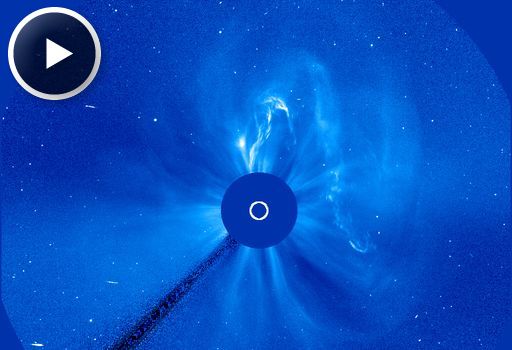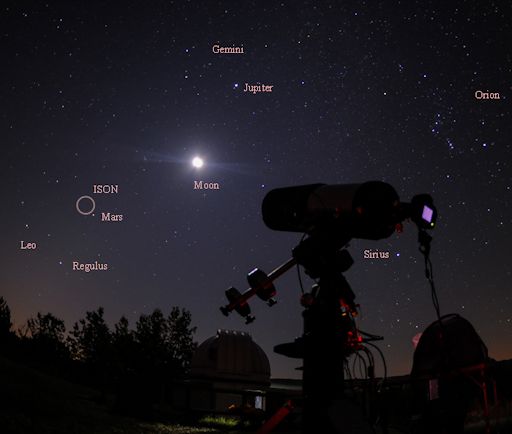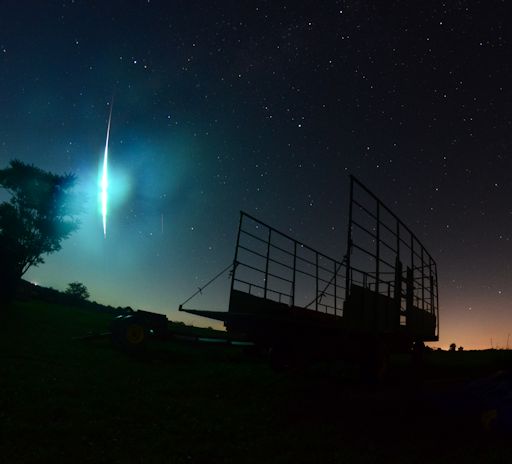When is the best time to see auroras? Where is the best place to go? And how do you photograph them? These questions and more are answered in a new book, Northern Lights - a Guide, by Pal Brekke & Fredrik Broms. | | |
COMET ISON FLYBY OF MARS: Today, October 1st, Comet ISON will fly by Mars at a distance of only 0.07 AU. Red Planet satellites and rovers have a ringside seat for the flyby, and they will be snapping pictures despite a shutdown of the US government. (Apparently, Curiosity has been designated "essential personnel.") Scroll past the Magnificent Eruption for more information.
INCOMING CME, CHANCE OF STORMS: NOAA forecasters estimate a 45% chance of polar geomanetic storms on Oct. 2nd when a CME is expected to hit Earth's magnetic field. SOHO photographed the CME leaving the sun on Sept. 30th traveling 900 km/s (2 million mph):

The CME was hurled into space by the eruption of a magnetic filament from the sun's northern hemisphere. One movie from NASA's Solar Dynamics Observatory shows the event in the context of the whole sun. Another movie zooms in for a closeup. It shows the filament ripping through the sun's atmosphere and leaving behind a beautiful "canyon of fire."
Forecasters expect the CME to deliver a glancing blow to Earth's magnetosphere, sparking G1- to G2-class geomagnetic storms around the poles. High-latitude sky watchers should be alert for auroras on Oct. 2nd and 3rd. Geomagnetic storm alerts: text, voice.
Realtime Space Weather Photo Gallery
COMET ISON'S FLYBY OF MARS: In two months, Comet ISON will make a spectacular flyby of the sun. First, though, it has to fly by Mars. Today, the comet is passing by the Red Planet only 0.07 AU (10.5 million km) away. This is giving Mars satellites and rovers our first close-up view of the sungrazer: video.
Amateur astronomers on Earth are watching the close encounter from afar. This photo from Malcolm Park of Oak Heights, Ontario, shows the location of the comet relative to Mars just before sunrise on Sept. 29th:

At closest approach, Mars and Comet ISON will be approximately 2o apart. While Mars is visible to the unaided eye (it shines almost as brightly as a first-magnitude star), ISON is not. The comet is still far from the sun and, as it crosses the orbit of Mars, it has not yet warmed enough to reach naked-eye visibility. Reports of the comet's brightness vary from 12th to 14th magnitude, which means a mid-sized backyard telescope is required to see it.
Mars and ISON rise together in the eastern sky a couple of hours before the sun. Amateur astronomers, if you have a GOTO telescope, enter these coordinates. Visually, Mars will be easy to find on the mornings of closest approach, not only because the planet is relatively bright, but also because the crescent Moon will be passing right by it. Sky maps: Oct. 1, 2.
New images of the comet are coming in every day. Browse the gallery for the latest views:
Realtime Comet ISON Photo Gallery
OHIO FIREBALL: On Sept. 27th, a meteor exploded in the skies above the US midwest. Witnesses report shadows cast upon the ground, unusual sounds, and a swirling contrail marking the aftermath of the blast. "It was the most brilliant fireball that I have ever seen!" reports Angela McClain, who sends this picture from Faith Ranch in Jewett, Ohio:

"The entire landscape lit up," she continues. "I spun around and there it was, a huge, bright green light, streaking across the sky. Even when it was gone, there was still a bright line in the sky about 20 seconds later. We were all stunned."
A NASA all-sky camera in Hiram, Ohio, also recorded the fireball: movie.
"This was a very bright event," says Bill Cooke of NASA's Meteoroid Environment Office. "Flares saturated our meteor cameras, and made determination of the end point (the terminus of the fireball's flight through the atmosphere) virtually impossible. Judging from the brightness, we are dealing with a meter class object."
Data from multiple cameras shows that the meteoroid hit Earth's atmosphere traveling 51 km/s (114,000 mph) and passed almost directly over Columbus, Ohio. Cooke has prepared a preliminary map of the ground track. According to the American Meteor Society, the fireball was visible from at least 14 US states.
Realtime Aurora Photo Gallery
Realtime Noctilucent Cloud Photo Gallery
[previous years: 2003, 2004, 2005, 2006, 2007, 2008, 2009, 2011]

